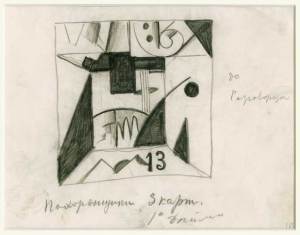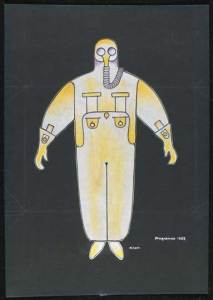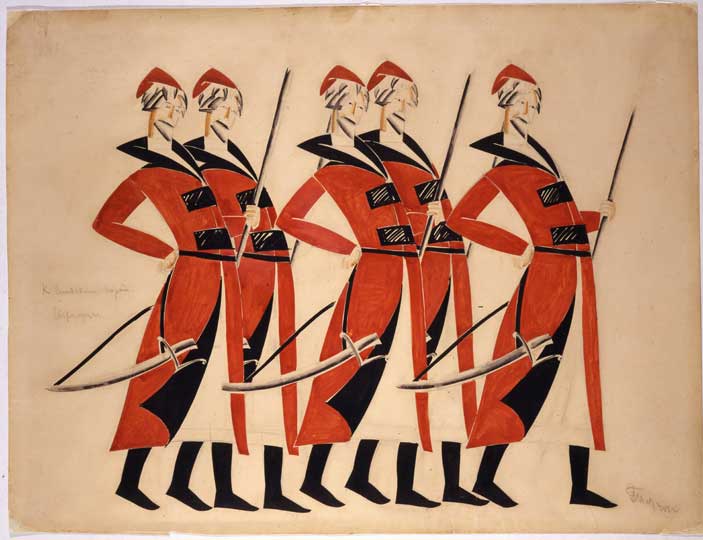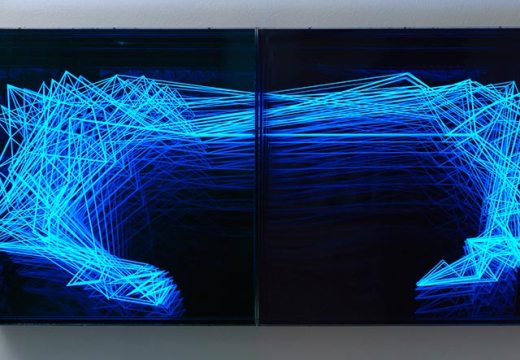There is something inherently melancholic about the V&A’s exhibition, ‘Russian Avant-Garde Theatre: War, Revolution and Design 1913–1933’. The exhibition brings together over 150 costume and set designs largely from the collection of the A. A. Bakhrushin State Central Theatre Museum in Moscow, and reveals how the radical artistic practice of figures such as Kazimir Malevich, Sergei Eisenstein and El Lissitzky first took flight in the theatre.
Forged in the furnaces of war and enflamed by the 1917 revolution, the sense of creative urgency over the 20-year period inspired a synthesis of art, design and performance, blending narratives from the folk to the futuristic. Nevertheless, that sense of euphoria is haunted by dramatic irony. We all know how the show will end: the rise of Stalin, the dominance of Socialist Realism, the persecution of the avant-garde. This is a story wound like clockwork, ticking towards its end.

Set design for Victory Over the Sun (1913), Kazimir Malevich © A. A. Bakhrushin State Central Theatre Museum
In the words of Malevich, ‘We, like a new planet on the blue dome of the sunken sun are on the cusp of a brand new world, and declare all things to be limitless.’ Each costume design, from the cavorting Cubist figures imagined by Alexandra Exter to the stark, linear skins outlined by Varvara Stepanova, proposes a character to populate that new world, participants in an ‘ideal performance’. This ideal, of a living symbiosis of word and image, body and set, is crystallised in Vsevolod Meierkhold’s philosophy of biomechanics, and in designs such as Lyubov Popova’s kinetic set for The Magnanimous Cuckold (1922). But such forms were ultimately deemed too fragmented, too abstract, to withstand the weight of Soviet ideology. The visions of the avant-garde, airy enough to rise glittering to the gods, came clattering down. We are left with a collection of static maquettes.

Costume design for Bedbug (1929), Alexander Rodchenko © A. A. Bakhrushin State Central Theatre Museum
These relics are revived at the V&A by the stories they were initially designed to enact. In both Vladimir Mayakovsky’s The Bed Bug, staged by Alexander Rodchenko in 1929, and Eugene O’Neill’s The Hairy Ape, performed in Moscow in 1926, the protagonist ends up banished to the level of the beasts. O’Neill’s ‘Yank’ dies in the arms of a gorilla in a Manhattan zoo, while the bourgeois Prisypkin is confined to the company of a bed bug. The world of The Hairy Ape couldn’t be further from Mayakovsky’s futurist vision of cryogenics and communism, but both plays are styled as cautionary tales about capitalism. A surprising amount of British drama makes an appearance; the plays of Wilde, Shaw and Chesterton assume new meaning under the mantle of Soviet ideology, where themes of purity and contamination are key.
The performances tend to oscillate between farce and tragedy – perhaps most characteristic is Mayakovsky’s Mystery Bouffe: A Heroic and Epic and Satirical Depiction of our Epoch (1918). Such a title might also be applied the UK–Russia Year of Culture, of which the exhibition forms a part. Earlier this year, UK ministers withdrew their support in response to Russia’s activity in the Ukraine. The programme continues to be staged by the British Council, and includes blockbuster events such as the Malevich exhibition at Tate Modern – but you can’t help but think that the utopian notion of ‘cultural exchange’ might have felt more genuine back in the age of hairy apes and bed bugs.
‘Russian Avant-Garde Theatre: War, Revolution and Design 1913–1933’ is at the Victoria & Albert Museum until 25 January 2015.
Unlimited access from just $16 every 3 months
Subscribe to get unlimited and exclusive access to the top art stories, interviews and exhibition reviews.














![Masterpiece [Re]discovery 2022. Photo: Ben Fisher Photography, courtesy of Masterpiece London](http://www.apollo-magazine.com/wp-content/uploads/2022/07/MPL2022_4263.jpg)
Why are fathers so absent from art history?